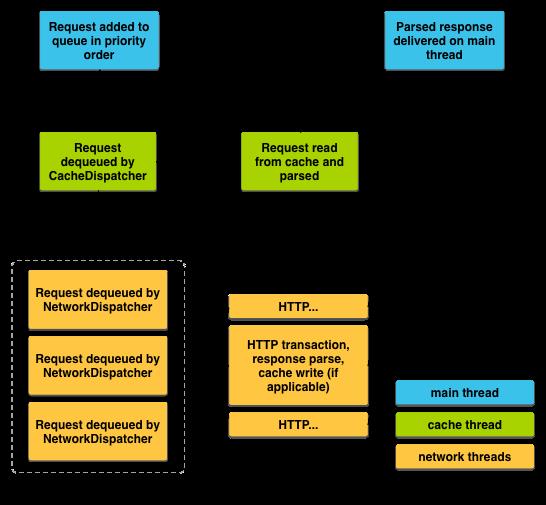android知识要点整理(14)----Volley(HTTP请求框架)
Posted znapast
tags:
篇首语:本文由小常识网(cha138.com)小编为大家整理,主要介绍了android知识要点整理(14)----Volley(HTTP请求框架)相关的知识,希望对你有一定的参考价值。
Volley是一个HTTP库,用于为android应用提供更见便捷快速的网络请求。Volley有以下特点:
- 自动调度网络请求
- 支持并发网络连接
- 屏蔽响应缓存细节
- 支持设置请求的优先级
- 支持取消单个或一组请求
- 容易定制请求
- 网络请求结果按请求顺序返回,这样更加方便控制UI的显示
- 提供调试和跟踪工具
但是,Volley**不适用于下载大文件和处理数据流**,因为Volley会将响应数据保存在内存中以方便解析。如果要下载大文件,建议使用DownloadManager.
我们使用Volley时,首先要创建请求队列(RequestQueue),然后构造请求(Request)添加到请求队列。RequestQueue维护一组工作线程用来处理这些请求,读写缓存以及解析响应数据。Request完成对原始响应数据的解析,然后通过Volley将结果传递给主线程。
使用Volley需要声明使用INTERNET权限。
发送简单请求
先看一个例子:
// 实例化请求队列
RequestQueue queue = Volley.newRequestQueue(this);
String url ="http://www.google.com";
// 构造请求,要求返回字符串形式的响应数据.
StringRequest stringRequest = new StringRequest(Request.Method.GET, url,
new Response.Listener<String>()
@Override
public void onResponse(String response)
// 展示响应结果
mTextView.setText("Response is: "+ response.substring(0,500));
, new Response.ErrorListener()
@Override
public void onErrorResponse(VolleyError error)
//提示错误
mTextView.setText("That didn't work!");
);
//将请求添加到队列
queue.add(stringRequest);当请求被添加到队列时,Volley运行一个缓存处理线程(cache processing thread)和一个处理网络请求的线程池来处理该请求。首先,请求会被缓存处理线程处理,如果缓存中有该请求的响应数据,直接读取缓存结果返回给主线程,否则网络请求处理线程会接手该请求,开始建立网络连接,获取网络数据并解析,然后将解析后的数据写入缓存并返回给主线程。所有的耗时操作都是在工作线程中完成。
它的流程图如下:

取消请求
使用canel方法可以取消还没返回结果的请求,调用取消方法后响应数据不会再被传递给主线程。我们可以取消单个请求,也可以通过标签(TAG)来取消一组请求。实例如下:
public static final String TAG = "MyTag";
RequestQueue mRequestQueue;
...
public void addRequest(Request request)
// 设置标签
stringRequest.setTag(TAG);
// 将请求添加到队列
mRequestQueue.add(stringRequest);
@Override
protected void onStop ()
super.onStop();
//在onStop中取消标签对应的所有请求
if (mRequestQueue != null)
mRequestQueue.cancelAll(TAG);
定制RequestQueue
Volley提供了一个简单的方法newRequestQueue()来创建请求队列,该方法使用默认的缓存、默认的http client。当然,我们可以自定定制缓存大小,决定使用什么样的http client。下面讲讲如何定制RequestQueue。
创建请求队列需要2种要素:网络(客户端)和缓存。网络用来传输请求,缓存用来处理缓存数据。Volley 工具箱提供这两者的标准试下:DiskBasedCache和BasicNetwork,前者提供缓存策略,针对每个响应都创建一个缓存文件,并在内存中保存该文件的索引,后者提供基于http client的网络传输,通常是基于HttpUrlConnection。
实例代码:
RequestQueue mRequestQueue;
// 创建缓存
Cache cache = new DiskBasedCache(getCacheDir(), 1024 * 1024); // 1MB 容量
// 使用HttpUrlConnection作为客户端来创建传输网络。
// HurStack 是基于HttpURLConnection 的HttpStack
Network network = new BasicNetwork(new HurlStack());
// 使用定制的缓存和网络栈构造请求队列
mRequestQueue = new RequestQueue(cache, network);
// 启动队列的线程
mRequestQueue.start();
String url ="http://www.example.com";
// ...
// Add the request to the RequestQueue.
mRequestQueue.add(stringRequest);
// ...创建单例模式的RequestQueue
如果应用中经常要用到网络,将RequestQueue设计成单例模式会是个很好的选择。这样能够确保在整个应用生命周期中,RequestQueue都是可用的,并且可以避免RequestQueue的重复创建和销毁,要做到这一点还要注意:应该使用Application Context 而不是Activity context。
下面是一个单例模式的实例:
public class MySingleton
private static MySingleton mInstance;
private RequestQueue mRequestQueue;
private ImageLoader mImageLoader;
private static Context mCtx;
private MySingleton(Context context)
mCtx = context;
mRequestQueue = getRequestQueue();
//提供加载图片的功能
mImageLoader = new ImageLoader(mRequestQueue,
new ImageLoader.ImageCache()
private final LruCache<String, Bitmap>
cache = new LruCache<String, Bitmap>(20);
@Override
public Bitmap getBitmap(String url)
return cache.get(url);
@Override
public void putBitmap(String url, Bitmap bitmap)
cache.put(url, bitmap);
);
public static synchronized MySingleton getInstance(Context context)
if (mInstance == null)
mInstance = new MySingleton(context);
return mInstance;
public RequestQueue getRequestQueue()
if (mRequestQueue == null)
// 注意使用Applicaton context,
//避免传进来的Activity context 导致 Activity 无法被回收
mRequestQueue = Volley.newRequestQueue(mCtx.getApplicationContext());
return mRequestQueue;
public <T> void addToRequestQueue(Request<T> req)
getRequestQueue().add(req);
public ImageLoader getImageLoader()
return mImageLoader;
加载图片
Volley提供了直接加载网络图片的功能。它提供了三种方式:
- ImageRequest.使用图片Url构造ImageRequest,响应回调函数会返回Bitmap对象。这种方法可以设置目标图片的尺寸。
示例:
ImageView mImageView;
String url = "http://i.imgur.com/7spzG.png";
mImageView = (ImageView) findViewById(R.id.myImage);
...
// 构造请求
ImageRequest request = new ImageRequest(url,
new Response.Listener<Bitmap>()
@Override
public void onResponse(Bitmap bitmap)
//在回调中将图片设置给ImageView
mImageView.setImageBitmap(bitmap);
, 0, 0, null,
new Response.ErrorListener()
public void onErrorResponse(VolleyError error)
mImageView.setImageResource(R.drawable.image_load_error);
);
MySingleton.getInstance(this).addToRequestQueue(request);- Imageloader.Volley提供的辅助类,用于加载和缓存网络图片。ImageLoader适用于需要构造大量ImageRequest请求的场景。它提供内存缓存,从而可以避免在屏幕旋转时因为图片重新加载而发生闪烁的情况。同时它可以缓存响应,在一定时候后将所有的响应同时返回给主线程,这样主线程可以集中处理图片的显示,避免UI重复layout,以提升性能体验。
ImageLoader mImageLoader;
ImageView mImageView;
private static final String IMAGE_URL =
"http://developer.android.com/images/training/system-ui.png";
//...
mImageView = (ImageView) findViewById(R.id.regularImageView);
mImageLoader = MySingleton.getInstance(this).getImageLoader();
//加载图片到指定ImageView
//同时指定默认图片和出错时的图片
mImageLoader.get(IMAGE_URL, ImageLoader.getImageListener(mImageView,
R.drawable.def_image, R.drawable.err_image));- NetworkImageView.基于ImageLoader的控件,用于替换ImageView来负责加载网络图片,同时在控件销毁时负责取消网络图片请求。
ImageLoader mImageLoader;
NetworkImageView mNetworkImageView;
private static final String IMAGE_URL =
"http://developer.android.com/images/training/system-ui.png";
...
// 实例化NetworkImageView
mNetworkImageView = (NetworkImageView) findViewById(R.id.networkImageView);
mImageLoader = MySingleton.getInstance(this).getImageLoader();
//直接指定图片url
//当然还要给出ImageLoader
mNetworkImageView.setImageUrl(IMAGE_URL, mImageLoader);请求JSON数据
Volley提供两个类用于发送JSON请求:JsonArrayRequest和JsonObJectRequest,它俩都是继承自JsonRequest。下面是个简单的例子:
TextView mTxtDisplay;
ImageView mImageView;
mTxtDisplay = (TextView) findViewById(R.id.txtDisplay);
String url = "http://my-json-feed";
JsonObjectRequest jsObjRequest = new JsonObjectRequest
(Request.Method.GET, url, null, new Response.Listener<JSONObject>()
@Override
public void onResponse(JSONObject response)
mTxtDisplay.setText("Response: " + response.toString());
, new Response.ErrorListener()
@Override
public void onErrorResponse(VolleyError error)
// TODO Auto-generated method stub
);
MySingleton.getInstance(this).addToRequestQueue(jsObjRequest);自定义Request实现
除了使用Volley提供的一些Request(比如ImageRequest)之外,我们还可以自己实现特殊的Request,步骤如下:
1.继承Request<T>,T代表响应数据要解析成的类型。比如ImageRequest 即是继承自Request<Bitmap>。
2.实现抽象方法parseNetworkResponse()和DeliverResponse()。具体方法如下:
parseNetworkResponse实现示例:(来自ImageRequest类)
@Override
protected Response<Bitmap> parseNetworkResponse(NetworkResponse response)
// Serialize all decode on a global lock to reduce concurrent heap usage.
synchronized (sDecodeLock)
try
return doParse(response);
catch (OutOfMemoryError e)
VolleyLog.e("Caught OOM for %d byte image, url=%s", response.data.length, getUrl());
return Response.error(new ParseError(e));
/**
* The real guts of parseNetworkResponse. Broken out for readability.
*/
private Response<Bitmap> doParse(NetworkResponse response)
byte[] data = response.data;
BitmapFactory.Options decodeOptions = new BitmapFactory.Options();
Bitmap bitmap = null;
if (mMaxWidth == 0 && mMaxHeight == 0)
decodeOptions.inPreferredConfig = mDecodeConfig;
bitmap = BitmapFactory.decodeByteArray(data, 0, data.length, decodeOptions);
else
// If we have to resize this image, first get the natural bounds.
decodeOptions.inJustDecodeBounds = true;
BitmapFactory.decodeByteArray(data, 0, data.length, decodeOptions);
int actualWidth = decodeOptions.outWidth;
int actualHeight = decodeOptions.outHeight;
// Then compute the dimensions we would ideally like to decode to.
int desiredWidth = getResizedDimension(mMaxWidth, mMaxHeight,
actualWidth, actualHeight, mScaleType);
int desiredHeight = getResizedDimension(mMaxHeight, mMaxWidth,
actualHeight, actualWidth, mScaleType);
// Decode to the nearest power of two scaling factor.
decodeOptions.inJustDecodeBounds = false;
// TODO(ficus): Do we need this or is it okay since API 8 doesn't support it?
// decodeOptions.inPreferQualityOverSpeed = PREFER_QUALITY_OVER_SPEED;
decodeOptions.inSampleSize =
findBestSampleSize(actualWidth, actualHeight, desiredWidth, desiredHeight);
Bitmap tempBitmap =
BitmapFactory.decodeByteArray(data, 0, data.length, decodeOptions);
// If necessary, scale down to the maximal acceptable size.
if (tempBitmap != null && (tempBitmap.getWidth() > desiredWidth ||
tempBitmap.getHeight() > desiredHeight))
bitmap = Bitmap.createScaledBitmap(tempBitmap,
desiredWidth, desiredHeight, true);
tempBitmap.recycle();
else
bitmap = tempBitmap;
if (bitmap == null)
return Response.error(new ParseError(response));
else
return Response.success(bitmap, HttpHeaderParser.parseCacheHeaders(response));
deliverResponse实现
@Override
protected void deliverResponse(Bitmap response)
mListener.onResponse(response);
以上是关于android知识要点整理(14)----Volley(HTTP请求框架)的主要内容,如果未能解决你的问题,请参考以下文章
Android 知识要点整理(12)----Animation(动画)